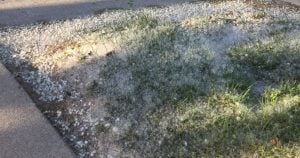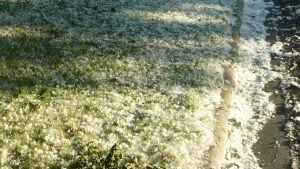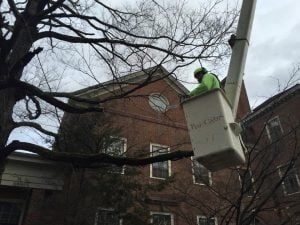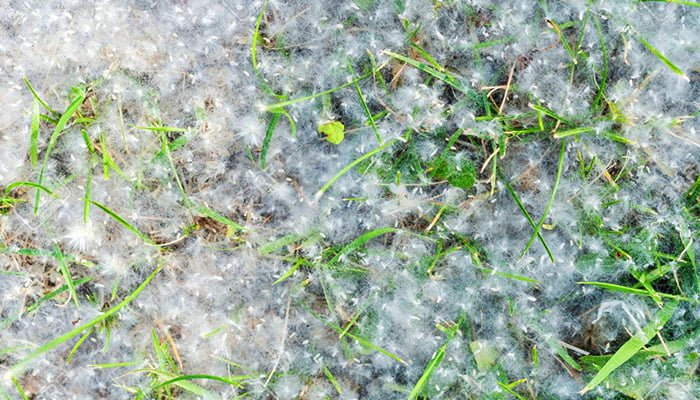Have you noticed fluffy white cotton-like objects floating through the sky? Or, maybe you noticed accumulation on the ground so thick it looks like snow? Rest assured, it is not snowing in June; it is just the seeds of cottonwoods.
What Are Cottonwood Trees?
 Cottonwoods are members of the Poplar family. They produce male and female parts on separate trees. In Spring, female trees produce small red blooms, followed by these masses of cottony seeds. Male cottonwoods do not produce seeds.
Cottonwoods are members of the Poplar family. They produce male and female parts on separate trees. In Spring, female trees produce small red blooms, followed by these masses of cottony seeds. Male cottonwoods do not produce seeds.
Similar to dandelions, cottonwoods use the wind to disperse their seed to new places. In the center of the loosely held together fibers is a seed. This seed will likely fall out in flight or very shortly after it hits the ground. Within a few days of landing, the seed germinates. Cottonwoods produce a very large number of seeds because very few seedlings survive this journey.
Planting Cottonwoods:
Cottonwoods will need a location with full sun and a lot of moisture to thrive. They grow very well near lakes and rivers as well as marshy areas. They prefer sand or silty soil. While pretty, planting cottonwoods on your property can lead to problems.
Cottonwood Tree Concerns:
 Cottonwood cotton can sometimes be a nuisance. During particularly productive Junes, it can cause clogged filters, collect in/clog gutters, and turn into clumps of fibrous mass in the rain. Additionally, cottonwood trees have weak wood and they are prone to disease and falling limbs. Cottonwood trees are one of the fastest growing trees in North America with the potential to reach well over 100 feet, often making them too large for residential landscaping.
Cottonwood cotton can sometimes be a nuisance. During particularly productive Junes, it can cause clogged filters, collect in/clog gutters, and turn into clumps of fibrous mass in the rain. Additionally, cottonwood trees have weak wood and they are prone to disease and falling limbs. Cottonwood trees are one of the fastest growing trees in North America with the potential to reach well over 100 feet, often making them too large for residential landscaping.
Cottonwoods Throughout The Seasons:
Summer – Brief “snowfall” followed by months of shade
Fall – Golden, fluttering leaves
Winter – Stark outlines of complex and tall design
Popular Uses For Cottonwood Trees:
Cottonwoods are excellent shade trees and windbreak trees, due mostly to their size. Their hollow trunks are also assets in wildlife areas providing shelter, and their twigs and bark provide a source of food. Pulp made from cottonwood creates a high-grade paper for books and magazines. The wood of cottonwoods is also often used to make pallets, crates, and boxes.
Cottonwood Maintenance:
 Pruning is a necessary cottonwood maintenance to control its growth and size. The best time to prune cottonwoods is in late winter during dormant stages. Pruning for proper growth while the tree is young is key. Since cottonwood trees are prone to disease, it is extremely important to be extra cautious when pruning and tending to these trees. Make sure your tools are clean, and remove branches that may rub during winds, as this can lead to significant wounds and disease.
Pruning is a necessary cottonwood maintenance to control its growth and size. The best time to prune cottonwoods is in late winter during dormant stages. Pruning for proper growth while the tree is young is key. Since cottonwood trees are prone to disease, it is extremely important to be extra cautious when pruning and tending to these trees. Make sure your tools are clean, and remove branches that may rub during winds, as this can lead to significant wounds and disease.
Knowing what trees are best to plant in your yard is an important first step in ensuring the safety of your property and the potential/ability for your landscape to thrive. Consulting with a professional to help you create a landscape plan best for your environment and tastes is a great idea! Properly and regularly maintaining all trees and landscaping on your property is also extremely pertinent in the health of your trees and shrubs.
If you’ve noticed these cotton seedlings flying through the air or accumulating on the ground, find comfort in the fact that this “snow” period is very short, and will be over soon. If you do live in an area with accumulation of cottonwood cotton, make sure to check your filters, gutters, and other potential clog sites regularly during June to avoid damages.
For your free landscape and landscape maintenance consultation contact Red Cedar Arborists & Landscapers!


